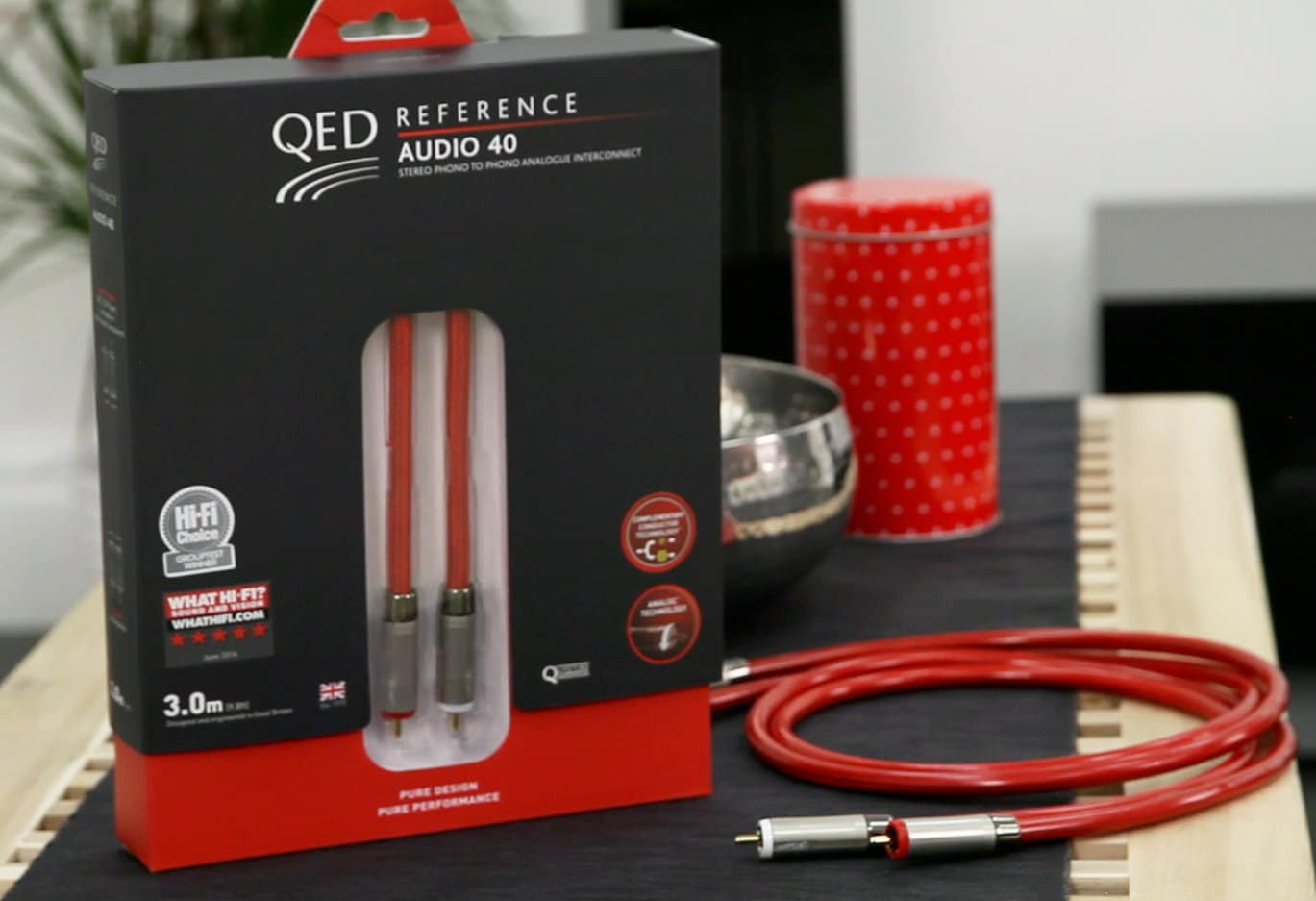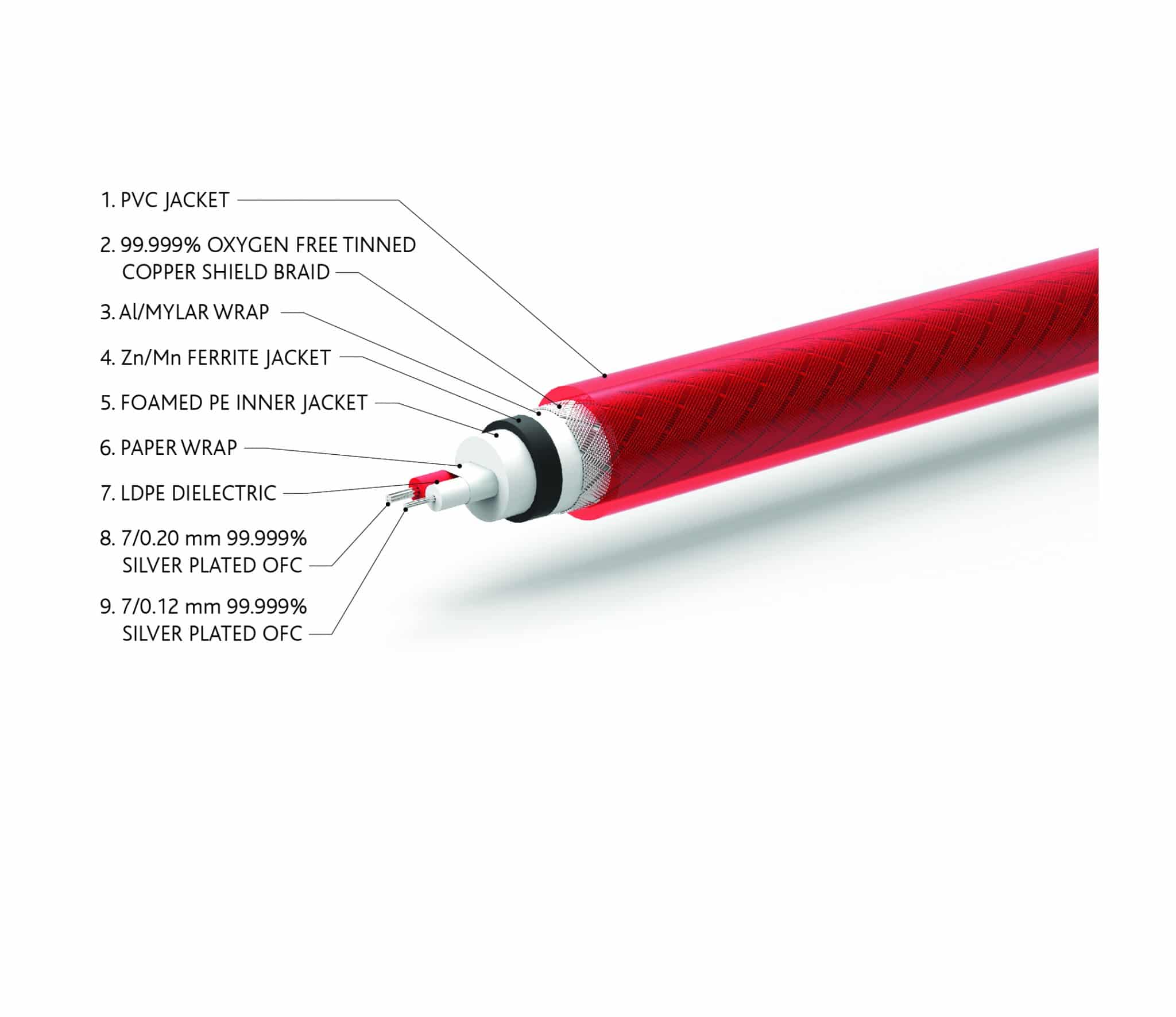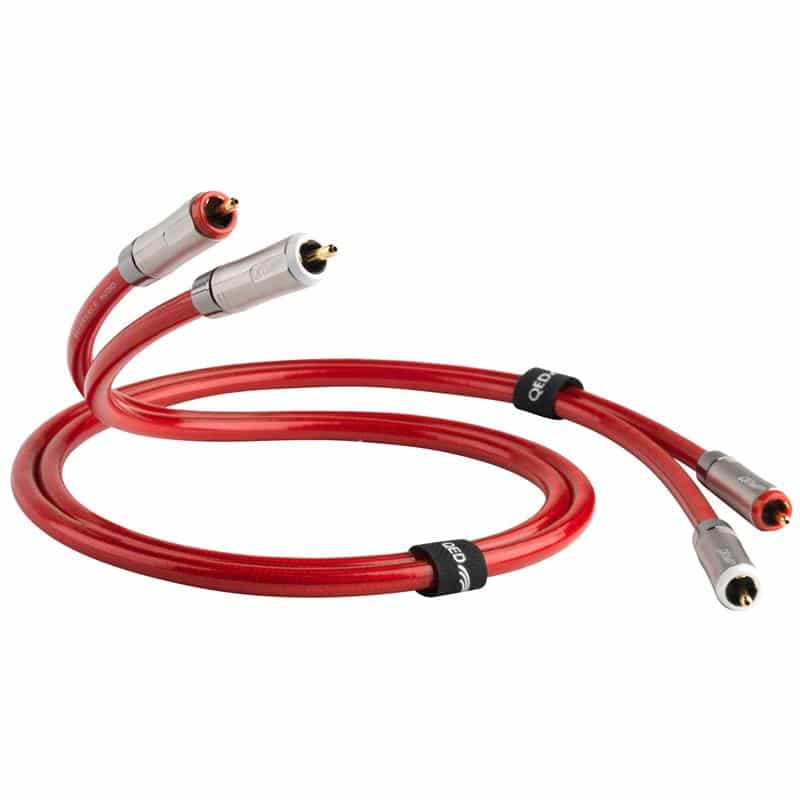The Article
QED Reference Audio 40: Reveal the Sound That’s Already There
29th November 2016

Considering upgrading your interconnect cables but worried about value for your money? Paul Rigby might just have the answer for you a he reviews the QED Reference Audio 40s
If you have been using a low cost set of interconnect cables for a while – possibly since you bought your hi-fi – upgrading them might be last on your list. I would encourage you to think again, though, and before you upgrade anything else too. Partly because bad or mediocre cables can do more to hamper the sound quality of your current set-up that just about anything else.
The job of a good set of cables is not to, as it where, ‘improve sound quality’ they’re really there to get out of the way. To allow you to hear what is already there in your hi-fi system. To fully hear what you bought in the first place. Cheap cables allow masking ‘noise’ to enter the hi-fi chain which means that all of those subtle parts of music like extended reverb tails, the metallic essence of a guitar string and the cloud effect of a struck cymbal are dulled and trodden on, turning them into something lifeless and faintly boring.
That was the aim of this review, to see if the QEDs could do that job.
The cables utilise two conductors of different diameters to carry the same audio signal. The reason, according to the company, is to, “…provide an alternative path for high frequency audio components which might otherwise become time smeared in a single audio pathway.” The cable has been created with silver-plated 99.999% Oxygen Free Copper (SPOFC) conductors with LDPE dielectric plus an OFC shield and a Zn/Mn ferrite jacket plus gold plated QED ‘Analoc’ RCA plugs.
SOUND QUALITY
I began the sound test with Dexter Gordon’s Three Little Words which has Gordon out of the right channel with the bass, piano and drums on the left. Firstly, in terms of Gordon’s own performance, the QED’s offered an immediate sonic personality. It’s a tough one to describe in a word or two. Let’s say, it had a sort of ‘freshness’. Put another way, the cables opened up the soundstage. Put a third way, there seemed to be lots of air and space in and around his solo stints that allowed the notes lots of room to manoeuvre, giving Gordon a sort of free and easy delivery. He could really stick out his elbows on this one and roam the stage with impunity. The upper midrange frequencies not only added extra latitude but their dynamic reach seemed to be extended.
On the left channel, this air and space, which I can only ally to a lowering of inherent noise, expanded the soundstage and was most obvious in terms of the percussion. Treble was now expansive, with cymbal work covering more of the left area of the soundstage, bass was almost flighty in its aspect while the piano was focused. The piano on this track can be a killer. Via poor quality cables, the piano can sound cold and foreboding. It can also sound constricted and almost irritable. Not here, there was both flow and a sense of circulation in how the piano was played.
I then moved to a more energetic track and played David Gray’s Babylon. I was most impressed by Gray’s own delivery. It had a sense of clarity that allowed his voice to move forward in the mix, adding a bit of 3D depth. The transparency in and around his vocal only adding to and enhancing his diction. The low noise aspect of the sound also encouraged the subtleties of his performance, including times where he pushed his voice slightly here and there, in terms of effort, to be easily heard.
Bass provided a meaty yet tight and compact presentation. There was no sense of bloom to smother other areas of the music spectrum. The low noise performance allowed the bass to remain succinct and to the point. That cleaner presentation from the soundstage also provided space for the background synths. In fact, the entire instrumental separation from the soundstage was most impressive.
On David Gahan’s lead vocal performance from Depeche Mode’s Enjoy the Silence, I noticed how focused his singing was. Sitting bang in the centre of the stereo image, the Gahan delivery was precise yet, because of the lack of distortive interferences, clear and recognisable. That lowering of noise affected the rear of the mix too, where the busy synth runs and effects lay. The QED allowed more of the subtle and often quite shy synth additions to reach the ear adding to the richness of the soundstage and a sense of layering in terms of the entire arrangement.
CONCLUSION
Offering incredible value for money, the QED Reference Audio 40 interconnects remove with one hand while giving with the other. That is, they take away the rubbish that might normally hang around your cable, veiling and submerging subtle detail. In return, the provide a nicely darkened background that encourages more detail to emerge forth, giving you detail, giving you clarity and giving you…hell, let’s just admit it…a pleasant listening experience. If you are living with bell wire or those basic cables that your dealer foisted upon you when you bought your system, seriously consider these interconnects. They’ll open a few sonic doors.
QED REFERENCE AUDIO 40
Price: £109.95
Website: www.qed.co.uk
Tel: 01279 501111
GOOD: price, low noise, instrumental separation, detail, midrange balance
BAD: nothing
RATING: 9
REFERENCE SYSTEM
Rega RP3 turntable
Trichord Dino phonostage
Leema Elements CD Player
Benchmark DAC2 HGC
Rega Brio-R amplifier
Spendor S3/5R speakers
Audiomica Vandini Gold 75 Ohm digital cable






I bought these recently and can vouch for their excellent quality in both sound and make. They certainly added a rich tone from a basic, one box hifi when hooked up to my Marantz HD Amp. I play DAB radio through it and mostly classical music. Voices and instruments have noticeably become richer and I recommend giving them an audition. It’s an obvious upgrade and I am sure these would give cables worth double the price a run for their money. Outstanding value.
Thanks for your user report, John. Appreciate it.
No problem, Paul. I just need to find a good match in digital coaxial cable now. I had an Atlas Ultra Ascent (the one you reviewed) and also a more basic QED reference cable (not the 40 version you reviewed) and I didn’t find much between them. I don’t think either have given me the richness this cable did but that maybe just down to the CD “harshness” that I read about. I am not a hifi expert by any means but I know what my ears hear. I have a Cambridge CXC transport plugged into the Marantz HD Amp. I have considered ditching that and getting the matching Marantz CD for ¬£370 instead of forking out ¬£200 on a cable. I dunno.
The Cambridge is excellent but, if you want to plug that into a DAC, there’s better options than the Marantz. For ¬£370…well, less, actually, I would plump for this Schiit DAC: https://schiit.eu.com/dacs/modi-multibit
Thanks for that, Paul. I have never heard of that brand or the product. Initial research online suggests it could be just the thing to give the digital sound a boost and more analogue feel, if I am correct in my terminology. And if you recommend it even more so… have you any personal listening experience of this product or others by Schiit?
Check out this news item, John: https://theaudiophileman.com/schiit-modi-multibit/
Here’s a review of one of their DACs, completed a while back but it might give you a flavour of the company style…https://theaudiophileman.com/gungnir-ho-schiit-gungnir-dac/
I am really taken by that Modi Multibit and just because it is from a lesser known brand doesn’t diminish it in my eyes, it is the sound that ultimately counts. I see that the Arcam irDAC-II is down to ¬£295 now with some retailers and has the same connections as the Multibit plus Bluetooth built in which would be a boon to me. It’s hard to demo these things though.
Both are recommended but I’d still plump for the Schiit.
hello paul.i want to ask you if it makes any sense to have only one quality cable like this.
and if its only one where is better to be conected? betwen the record player and the pre-amp,
or pre-amp and amp.thank you.
Thanks for the question, Ioannis. The ideal is to install quality cables throughout but if you’re on a budget then start at the source and work your way along to the speakers.
I have the Qed Performance Audio 2, a copper IC cable. Don´t know if the Refrence 40 would be a upgrade, or just diferente. I like the energetic sound of the Audio 2, the reference 40 is energetic too, or not?
Hi Nuno – the References are superior but if you were looking to upgrade from the already good quality Performance units then I would encourage leap-frogging the References for the next one up from there to maximise your money and any sonic improvements.
And the Chord Clearway is a good alternatve?
I’d look at Tellurium Q Blues, Nuno.
hello paul.i’m looking for a pair of bookself speakers.could you tell me if the audio cambridge https://www.cambridgeaudio.com/usa/en/products/speakers/minx-xl are the same product with https://www.cambridgeaudio.com/gbr/en/products/speakers/sx-50 with different cabinet? and what do you think of them? thank you.
These speakers have passed me by, I’m afraid and I’m unable to contact the company to make further enquiries at this time but the Minx are more expensive. I reckon they are basically the same is basic design. It might be a superior cabinet perhaps? I’m only guessing though.
Before you dive in, though, check these out for £148. Superb value and great sound: https://www.amazon.co.uk/Acoustics-Bookshelf-Speakers-American-Walnut/dp/B00TR7JK7Q/ref=sr_1_1_sspa?ie=UTF8&qid=1535287159&sr=8-1-spons&keywords=q acoustics 3020&psc=1&smid=ANNASRW22SIOH
I’ve just bought a couple of pairs of these on the back of this review (and as they are now retailing for around ¬£80 a pair), I left them burning in for several days attached to an old minidisc player and rca switch. They’ve replaced my Epiphany Acoustics Atratus cables and connect an Audiolab 8200CD and Graham Slee Era Gold V phono to a Cyrus 6XP Amp.
In a word, wonderful. It feels like everything has just grown up and stopped messing about, seriously pleased.
Great stuff, Graham! Happy that you’re happy, as it where 🙂 Your hi-fi kit certainly has the capacity to shine through those cables.
Did you get the chance to also test the Signature 40?
Not yet, I’m afraid Sebastian.
Hi Paul,
Do you know if the Chord Clearway is better than the Reference, or is similar?
Both are excellent – I’d lean towards the QED though.
Hi Paul,
Thanks for all these reviews.
Do you think that there is a very huge difference between the Reference 40 here and the new Performance 40i (you reviewed too) ?
I need a new interconnect between my Technics SL-1200GR & the pre-amp and the Performance 40i got a lower capacitance than Reference 40 (between the turntable & the pre-amp, capacitance matters).
2 options :
1st: one Performance 40i between turntable & pre-amp one Reference 40 between the pre-amp & amplifier (Naim)
2nd: two Performance 40i for the same job
If budget don’t matter, why do you think about those 1st and 2nd options ?
‘Huge’ is in the ear of the beholder, Jean-Chris 🙂 Huge is certainly arguable but the difference exists and, if it was me, I’d *know*. And because I knew there was a difference then I’d have to do something about it.
Paul. Thanks for the reply.
Nevertheless, english is not my native language & therefore, I doesn’t understand the subtlety of your reply 🙂
No problem, I’ll put it another way. There is a difference in sound quality and the 40i is highly recommended. So yes, go for that. Of course, if you want a larger improvement there are other cables on the market that will supply those improvements but they are, as you might expect, more expensive.
Thats interesting to you say that…what would you recommend as a step up…thanks.